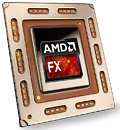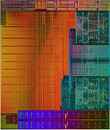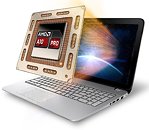Wednesday, June 4th 2014

AMD Announces Its Most Advanced Mobile APU for Consumer and Commercial Notebooks
AMD (NYSE: AMD) today introduced its new 2014 Performance Mobile APUs designed for ultrathin and high-performance mobile PCs, bringing the features and capabilities of the popular and powerful AMD A-Series APU family (codenamed "Kaveri") to power-efficient notebooks for both personal and professional use. The new mobile APUs mark the debut of Heterogeneous System Architecture (HSA) features and Graphics Core Next (GCN) Architecture for mobile devices, establishing them as AMD's most advanced mobile APUs to-date. Notebook and desktop systems powered by AMD's entire 2014 APU lineup, including systems from Acer, Asus, Dell, HP, Lenovo, Samsung, Toshiba and others also debuted at COMPUTEX TAIPEI 2014.
"AMD takes a major step forward today on our journey to transform and enhance the computing experience with the launch of the 2014 Performance Mobile APU family," said Bernd Lienhard, corporate vice president and general manager, Client Business Unit, AMD. "With a combination of superior total compute performance, stunning graphics and efficient power use alongside industry-first technologies, these new APUs set a new bar for cutting-edge consumer and commercial PCs."
The announcement of the 2014 Performance Mobile APU family features AMD's first FX-branded enthusiast-class APU for notebooks, and follows the recent introduction of AMD's 2014 Low-Power and Mainstream APUs.Introducing AMD PRO
Responding to the needs of an evolving commercial marketplace for longevity, performance and stability in enterprise systems, AMD has introduced a professional line of the Performance Mobile APUs. Designed especially with business in mind, AMD PRO A-Series components offer outstanding stability and longevity, and enable open, industry-standard DASH manageability.
In conjunction with today's AMD PRO A-Series announcement, HP unveiled a complete lineup of Elite commercial PC designs featuring the AMD PRO series. The HP systems include the EliteBook 725, 745 and 755 G2 notebook, the EliteOne All-in-One and the EliteDesk desktop PCs.
AMD 2014 Performance Mobile APU Features
Revolutionary Architecture
"AMD takes a major step forward today on our journey to transform and enhance the computing experience with the launch of the 2014 Performance Mobile APU family," said Bernd Lienhard, corporate vice president and general manager, Client Business Unit, AMD. "With a combination of superior total compute performance, stunning graphics and efficient power use alongside industry-first technologies, these new APUs set a new bar for cutting-edge consumer and commercial PCs."
The announcement of the 2014 Performance Mobile APU family features AMD's first FX-branded enthusiast-class APU for notebooks, and follows the recent introduction of AMD's 2014 Low-Power and Mainstream APUs.Introducing AMD PRO
Responding to the needs of an evolving commercial marketplace for longevity, performance and stability in enterprise systems, AMD has introduced a professional line of the Performance Mobile APUs. Designed especially with business in mind, AMD PRO A-Series components offer outstanding stability and longevity, and enable open, industry-standard DASH manageability.
In conjunction with today's AMD PRO A-Series announcement, HP unveiled a complete lineup of Elite commercial PC designs featuring the AMD PRO series. The HP systems include the EliteBook 725, 745 and 755 G2 notebook, the EliteOne All-in-One and the EliteDesk desktop PCs.
AMD 2014 Performance Mobile APU Features
Revolutionary Architecture
- Up to 12 Compute Cores (4 CPU + 8 GPU) deliver amazing performance and responsiveness, bringing to life the full capability of the APU on various workloads and applications
- The breakthrough new Heterogeneous System Architecture (HSA) allows the CPU and GPU to work together in harmony by quickly dividing and directing the right tasks toward the appropriate cores for new levels of performance and efficiency in consumer and commercial desktop and notebook PCs, thus enabling a new era of compute capabilities with compute cores
- Award-winning Graphics Core Next Architecture with AMD Radeon R7 series graphics and compute capability
- Support for UltraHD (4K) resolutions and new video post-processing enhancements that make 1080p videos look amazing when upscaled on an UltraHD-enabled monitor or TV
- Support for AMD's acclaimed Mantle API that simplifies game optimizations for programmers and developers to unlock unprecedented levels of gaming performance3
- AMD Radeon Dual Graphics provide a performance boost from 49 percent to 108 percent4 for the ultimate gaming experience
- Experience-enhancing features such as AMD Quick Stream, AMD Steady Video and AMD TrueAudio technologies combine to deliver lifelike audio and video5
- A10-APU: Up to 50 percent better graphics performance6 and more than 1.2x the compute performance7 versus Intel i5-4200U ("Haswell")
- FX APU: Up to 58 percent better graphics performance8 and more than 1.13x the compute performance9 versus Intel i7-4500U ("Haswell")
- FX APU: Up to 40 percent more graphics performance-per-watt10 than our previous generation
- FX APU: Up to 30 percent more system compute-per-watt11 than our previous generation



16 Comments on AMD Announces Its Most Advanced Mobile APU for Consumer and Commercial Notebooks
I kinda question why stop with so few GPU compute cores? Why not just add a feature where the GPU can be disabled for graphics entirely? Shift more cores over to help compute. Unless of course they're working on this and we'll see it in the future. Really some will not be using the IGP and it would be a neat idea to dedicate them while they run off discrete GPUs.
Course with all first gens....it'll likely suck compared to the 2nd and 3rd gens.
"After delaying for about forever the A8-7600 on the desktop, because they possibly realized that it was so good that it would kill the A10 sales,"
From my perspective, this is exactly why they need to keep some features exclusive to FX/A10 in order to get people buying those instead. Only time will tell if it's a good strategy, but I think it's the right move to get higher profit margins on a few segments, which is something they naturally want. And who knows, in the future [some of] these features might in some form or another trickle down in the lower segments if they see a clear demand there.
Others, even worst, will just go for an Intel set up having less features to justify going for a Kaveri.
AMD should stop worrying about internal competition. It doesn't matter if you have internal competition if you have zero market share.
I really don't know why this company keeps shooting it's feet when it is running in front of the competition.
congratulations, your 35 watt "quad core" can beat a dual core intel chip that pulls 17 watt. how does it compare to the likes of a 37 watt, say, i5 4300m? the slowest quad core i7, the 4702, would wipe the floor with amds quad core.
Granted most of the tests in that review focus on gaming (IGP) but AMD's not half bad in everyday tasks, especially considering the price of i7-4702MQ :rolleyes:
20% IPC improvement ? What are they comparing it to ?
i7-4702MQ has HD 4600 on it.
2 quoted in AMD numbers i5 4200u and i7 4500u are HD 4400 gpu's.
On intel's website I found out the following information:
The cheapest i7 with HD5000 on intel's site starts at 426$
The cheapest i5 with hd5000 graphics starts from 315$
the cheapest i3 with hd5000 graphics starts from 315$ as well.
The prices for mobile kaveri are not out yet. But I don't think they'll be much higher than low to mid 200s for the top sku. That would mean that AMD would be a no-brainer vs an i3, but once you get to i5 levels of performance, things start to get more blurry.